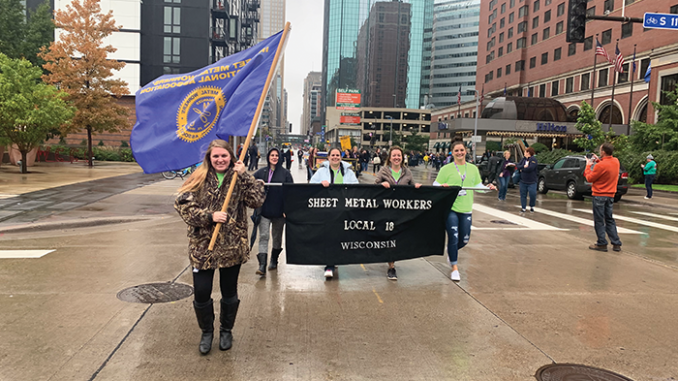
By / Natalie Bruckner • Photos courtesy of Local 28
When it comes the sheet metal industry, or any construction trade for that matter, it has been well documented that women remain seriously underrepresented. Recent studies suggest that women working in construction make up 10.3% of the workforce in the United States and 12% in Canada. Even smaller is the number of female construction workers on the front lines of a job site: one woman for every 100 employees on the field.
To address this, SMACNA and SMART have been ramping up efforts to double the number of women in the industry within the next five years.
A lofty goal perhaps, especially during these trying times, yet with numerous efforts going on across the country and the sharing of information, it’s an achievable goal… as long as the efforts are ongoing.
“When I started as the training director back in 2011, I made it my mission to start pushing the recruitment of more women in our industry,” says Leah Rambo, director of training for Local 28—Metropolitan New York & Long Island. “Back then female members accounted for only three per cent at our apprenticeship program, but after continuous recruitment efforts and introducing a direct entry program, we managed to increase that number to 11%.”
In Rambo’s own words, the way to do it was to become a “pain in the neck” by continually asking why women weren’t being recruited and offering help to find ways to attract suitable candidates. It was a strong approach, but one that worked.
However, Rambo says that when they reached the 11% mark she made the mistake of thinking that upward curve would naturally continue. “I slowed down my efforts because I thought it would increase organically, but it was way too soon to celebrate,” she says. “The numbers started to drop. I realized you can never take your eye off the ball. We ramped up our efforts again and started knocking on doors. Today we are up to 14%, the highest in the nation for sheet metal.”
Local 28 is proof that to succeed you cannot take your foot off the accelerator. Organic growth won’t happen overnight, or even in 10 years, for that matter. “According to statisticians, the celebration number, before organic growth can actually happen, is closer to 30%,” Rambo explains. “My goal was to have 20% women by 2020, but with what is happening right now with COVID-19, I won’t end up having the recruitment. But, I know that, because of my efforts in getting the word out there, the direct entry into the industry will be about 25% women.”
Across the country there are various examples of efforts underway to address the challenge of attracting women into the industry, one of which is to create women’s specific groups. The goal is also to make the industry a more comfortable and welcoming space that will not only benefit women in the industry today, but will iron out issues to better pave the way for future sheet metal sisters.
However, don’t be mistaken. This isn’t a “ladies only” coffee get-together. Over at the Local 18 Women’s Committee in Wisconsin, for example, the men are extremely active in the group, at the request of the women.
“When we started up the Women’s Committee back in 2018, we told the women we would be available to help facilitate whatever they needed but they were adamant that they wanted us at the meetings,” says Mike Mooney, president/business manager at Local 18. “We learn so much. Their devotion to the trade is second to none.”
Local 18’s staff originally came up with the idea of creating a women’s committee after realizing they needed help, not only attracting women into the industry, but in retaining them.
“There has always been an issue with getting minorities in the trade in Wisconsin—and keeping them,” says Hallie Jennerman, statewide organizer. “We were at approximately one per cent women and know SMART general president Joe Sellers would like to see a 20% female rate, which is ultimately our goal, too. We have a long road ahead of us, but we are committed. We understand it’s about listening to the needs of women in the industry and responding accordingly.”
In addition to holding regular meetings and outreach programs, Local 18 is extremely active in the marketing space. To raise awareness of Local 18’s Women’s Committee the team came up with the concept of Rosie The Tinner—a figure that acts as a symbol to demonstrate the power and strength of women in the industry.
“We started out by making hardhat stickers of Rosie the Tinner to draw attention to the Women’s Committee, and it really took off,” says Stu Wilson, Local 18 business representative. “Then we started making t-shirts with Rosie the Tinner on them, and recently, we have been sending out the stickers with metal nose strips we’ve been manufacturing to help make homemade face masks more effective against COVID-19. We have had women calling us up asking about the stickers. It’s about getting the message out there, however we can, to a wider audience.”
When it comes to one of the most effective means of attracting women into the trade, beyond word of mouth of course, SMACNA and SMART are in agreement that there is no stronger message to say women are welcome in the industry than to have women in the industry.
“Recently, I was on a panel for women in construction and we all mentioned that we never intended to get into the position we are in,” says Angie Simon, president of Western Allied Mechanical in California and SMACNA national president. “I mean, I never desired to be the president of my company. At the end, during the Q&A, this young lady from the audience said that she didn’t understand why I didn’t want to be the president of my company and explained, ‘I see you guys and that’s what I want to be.’ You have to see it to want to be it. I think the challenge for us back when I got into the industry was that we didn’t think it was a possibility because there were no women in those positions.”
Simon adds that while this is slowly changing, there are still very few women at the top, so a change in attitude of the guys at the top is needed to reach the goal of doubling the number by 2025. “We are fortunate to have Joe Sellers who is not just talking the talk, but walking the walk,” Simon says. “He joins in on women’s leadership groups and listens. He is committed to making a difference.”
Over at Local 18 they are actively seeking out females to run for leadership positions and encouraging promotion within. And as Simon says, it’s not about getting the numbers of women up, but about getting the best person for the job. “We hire the best available people, and it so happens that a lot of times it’s a woman. It’s not that we focus on women, but having a woman in the leadership position definitely helps attract other women.”
Rambo says that in order to move forward successfully, the industry needs to listen. “If you are the president of your Local, ask your members and staff, ‘Would you like your daughter to come and work in the industry?’ If they say no, then ask why. We have to be willing to look the ugly in the face.” ▪



